Abstract
One of the most widely studied potential markers associated with life expectancy and resistance to stress is terminal regions of chromosomes - telomeres. The telomere theory of aging claims that telomeres are both a marker of cellular aging and its main cause. Short telomeres are a risk factor for age-related diseases. Recently, quite a few studies appeared that revealed accelerated telomere shortening as a response to long-term psychological stress. Working on the destruction of chemical weapon was stressful for people who conducted this task in the Russian Federation. Our research included general medical and psychological examination, as well as measurement of telomere lengths of peripheral blood lymphocytes, and determination of alleles of the serotonin system genes, i.e. serotonin receptor 2A 5-HTR2A (102T>C polymorphism, alleles A1 and A2) by 87 people who took part in the demolition of chemical weapon, and by 65 in control group. Serotonin system is actively involved into the body's response to stress, thus the aforementioned alleles should be regarded as most significant. It was shown that the maximal and the average length of telomeres in the main group were higher than those in the control group, while minimal telomere lengths did not differ significantly. Joint examination of telomere lengths, age and genetic polymorphism, demonstrated that the length of telomeres tended to decrease with age by carriers of genotypes A1A2 and A2A2, and to a much smaller extent than by carriers of A1A1. Thus, carriers of the A2 allele proved to be more resistant to long-term stress.
Keywords: Long-term stressserotonin receptor 2ATelomere length
Introduction
Among the existing theories of aging, the telomere theory takes the leading place (Anisimov, 2003). To date, many studies have been done that describe the relationship between the processes of normal and accelerated aging with telomere length (Bernadotte, Mikhelson, & Spivak, 2016).
Telomeres light and telomerase activity
Short telomeres are a risk factor for many age-related diseases, including cancer (Wentzensen, Mirabello, Pfeiffer, & Savage, 2011), cardiovascular disease (D'Mello, Ross, Briel, Anand, Gerstein, & Pare, 2015), and diabetes (Zhao, Miao, Wang, Ding, & Wang, 2013). Recently, quite a few studies appeared that reveal accelerated telomere shortening as a response to long-term psychological stress (Epel, Blackburn, Lin, Dhabhar, Adler, Morrow, & Cawthon, 2004), as well as by various psychiatric disorders (Wolkowitz et al., 2011). In this case, the body is exposed to increased oxidative and inflammatory stress (Mikhelson & Gamaley, 2010), to malfunctions of mitochondria, and also sharply reduced the activity of the telomerase enzyme, which is able to lengthen telomeres (Spivak, Mikhelson, & Spivak, 2016; Kovalenko, Zhdanov, & Kovalenko, 2013). One might suppose that long-term stress could result not only in the telomere shortening (Epel et al., 2004), but, on the contrary, in the appearance of a compensatory reaction, related to increase in telomerase activity (Tolahunase,Sagar, & Dada, 2017; Beery et al., 2015; Lengacher et al., 2014; Zalli et al., 2014). Increase in telomerase activity is currently not treated as unambiguously as before. According to earlier views, decrease in telomerase activity in peripheral blood lymphocytes accompanies cellular aging and, consequently, the aging of the whole organism. This is also the case of action of psychological stress or, of various diseases (Bernadotte, Mikhelson, & Spivak, 2016; Spivak, Khesina, & Spivak, 2015). Meditation has been proved to be able to alter this regularity (Lavretsky et al., 2013; Schutte & Malouff, 2014); the same is the case of lifestyle management (Daubenmier et al. 2012.), psychological stress reduction (Epel, Lin, Dhabhar, Wolkowitz, Puterman, Karan, & Blackburn, 2010), decrease in low-density lipoproteins (Ornish et al., 2008.). At the same time, the combination of short telomeres and high telomerase activity has been shown to be associated with various risk factors, including chronic psychological stress (Zalli, Carvalho, Lin, Hamer, Erusalimsky, Blackburn, & Steptoe, 2014). Kim et al. (2017) found that patients with the most severe form of post-traumatic stress disorder in response to the action of antidepressants demonstrate telomere lengthening. Basing on these results, a new concept of stress response was recently formulated: it can either bring about decrease in telomerase activity, leading to shortening of telomeres - or, an increase in telomerase activity, allowing it to maintain telomere length or even to increase it (Beery, Lin, Biddle, Francis, Blackburn, & Epel, 2012; Deng, Cheung, Tsao, Wang, & Tiwari, 2016).
Serotonin receptor 2A gene polymorphism
Adaptation to stress in the human body is carried out by the hypothalamic-pituitary-adrenal system (GGNS). One of the mediators of this is serotonin. Serotonin enters the synaptic cleft, part of it binds to a number of receptors of the serotonergic system, including the serotonin receptor type 2A to trigger the signaling cascade. One of the most significant and studied polymorphisms of the 5-HTR2A gene is single nucleotide substitution of thymine for cytosine in 102 position (102T> C). The results of the research show that this polymorphism is associated with various mental illnesses and behavioral reactions. (Golimbet, Alfimov, Mityushin, & Asanov; 2003; Schosser & Kasper, 2009). Numerous studies have been carried out linking C102T polymorphism of this gene with different reactions to stress, but their results are ambiguous. Many results suggest that C102T (rs6313) polymorphism of 5-HTR2A gene, but not A1438G (rs6311) and C1354T (rs6314) polymorphisms, may be involved in the susceptibility to suicide, larger possibility of stressful life and loss events (Ghasemi, Seifi, Baybordi, Danaei, & Samadi, 2018). Another study, performed by Höfer et al. (2016) showed no association present between 5-HTR1A or 5-HTR2A gene polymorphisms and both current suicide risk and personal history of suicide attempts. In addition, epistatic effects of 5-HTR1A and 5-HTR2A genes upon suicidal behavior were not significant, although sample size limitations do not allow definitive conclusions. The interaction of reported childhood adversity and a polymorphism in the 2A serotonin receptor was associated with higher depressive symptoms; detailed analysis showed that gene-environment interaction was mediated by cultural consonance in family life, and that these effects were more pronounced in lower social class neighborhoods (Dressler, Balieiro, Ferreira de Arajo, Silva Jr, & Ernesto Dos Santos, 2016a). However, in another experiment gene-environment interaction of this kind was not replicated (Dressler, Balieiro, Ferreira de Arajo, Silva Jr, & Ernesto Dos Santos, 2016b).
Findings of Matsunaga et al. (2017) suggest that 5-HTR2A polymorphisms are associated with the effect of sharing happiness by modulating the activity of the mentalizing/theory-of-mind network.
Individuals with A2A2 genotype were also shown to be able and willing to spontaneously adopt the point of view of others, more likely to be anxious when observing pain endured by others, and more likely to have communication problems. Moreover, the genotype effect on communication problems was mediated by individual ability of ‘perspective taking’(Gong, Liu, Blue, Li, & Zhou, 2015). These findings provided evidence that the HTR2A T102C polymorphism served as a predictor of individual differences in empathic and autistic-like traits, which highlighted the role of this gene in the connection between ‘perspective taking’and autistic-like traits. Chang, Fang, Chang, Chang, Shyu, & Huang (2017) showed that individuals with homozygous A2A2 exhibit diminished resting vagal tone-an index of stress vulnerability-when experiencing chronically elevated levels of perceived stress. Acute and long-term use of psychedelics is associated with personality changes that appear to be modulated by 5-HT2A receptors (Bouso, Dos Santos, Alcázar-Córcoles, & Hallak, 2018).
Studies of genetic polymorphism of genes of the serotonin system are supplemented with the epigenetic ones. Epigenetic alterations in the serotonin system may underlie the effect of early life stress on psychopathology. The serotonin system is sensitive to stress exposure and psychopathology, and HTR2A methylation may serve as a mechanism by which early adversity is biologically encoded (Parade et al., 2017).
Problem Statement
Comparison of data on the effect of stress on the length of telomeres and the role of polymorphism in the genes of the serotonin system in mediating this effect led us to search of a direct link between the genetic background and the telomere response to stress. In Han Chinese, shorter leukocyte telomere length is significantly associated with the 5-HTTLPR S/S allelic variant, which may be implicated into psychological stress-related health problems (Li et al., 2014). But aforementioned psychological factors were not taken into account.
Mitchell et al. (2014) reported occurrence of significant associations between low income, low maternal education, unstable family structure, harsh parenting - and telomere length. These effects were moderated by genetic variants in serotonergic and dopaminergic pathways. Consistent with the differential susceptibility hypothesis, subjects with the highest genetic sensitivity scores had the shortest telomere length, when exposed to disadvantaged social environments and the longest telomere length, when exposed to ‘advantaged environments’. However, the 5HTR2A polymorphism was not included into this study. Father loss is definitely linked to his children's salivary telomere length, the way losing one’s father being highly important. At the same time, there was no reliable correlation between the degree of telomere shortening and the polymorphism of serotonin system genes (Mitchell, McLanahan, Schneper, Garfinkel, Brooks-Gunn, & Notterman, 2017).
Research Questions
Destruction of chemical weapon is a highly stressful and harmful activity. The question of how workers cope with this long-term stress, whether it affects the length of telomeres, and whether the body has got some kind of basic defense against such stress requires an urgent answer. Is it possible to determine a greater or smallerdegree of professional competence forpeople intending to work in such difficult conditions? Works linking difficult working conditions with the polymorphism of the 5-НТR2A gene were conducted in China. Wu, Wang, Zhou, Gu, & Yu (2016) found that the risk of depression by people working at a thermal power plant with high-level daily hassles and / or with more negative emotions, who carried A1A2 genotype or, A2A2 genotype of T102C, was 5 to 8 times higher than that in those with low-level daily hassles and / or with less negative emotions, who carried A1A1 genotype. Oilfield workers with A2A2 and A1A2 genotypes had significantly higher role boundary scores than those with A1A1 genotype, and workers with A2A2 genotype had a significantly higher vocational stress score than those with A1A2 genotype (Jiang, Palizhati, Gao, Guan, & Liu, 2016). Unfortunately, in these studies there was no such marker of general health as telomere length.
Purpose of the Study
Purpose of this study consists in analysis of a marker of general health status (telomere length), in its connection with polymorphism of serotonin 2A receptor gene (5-HTR2A), in workers exposed to severe psychological stress, regarded basing upon the model of taking part in destruction of chemical weapons. A more general perspective consists in ranging professionals intending to work in conditions of long-term stress, basing on data of genetic screening.
Research Methods
Main and control groups
To answer the aforementioned basic question, a study was conducted in which two independent groups participated. The main group, consisting of 87 people, included workers in chemical production from 25 to 44 years (mean age ± SD = 33.6 ± 3.81 years), involved into destruction of chemical weapon.
Control group, consisting of 63 people, included volunteers aged 18 to 39 years (mean age ± SD = 25.5 ± 4.10 years). All respondents were mentally healthy and participated voluntarily in the study.
DNA extraction
Lymphocyte fraction of peripheral blood was used in the research. DNA isolation was performed with the help of the Syntholcompany (Russia), according to the attached isolation protocol.
Purity and amount of the isolated genomic DNA were evaluated spectrophotometrically, using a Nanodrop-1000 instrument (Thermo Scientific, USA).
Measurement of telomere length
Measurement of telomere length in the lymphocyte fraction of peripheral blood was carried out by quantitative real-time PCR method according to the original protocol, taken from literature (Eastwood, Mulder, Verhulst, & Peters, 2017). Mean length of telomeres in the sample (in kbp) was calculated according to the standard procedure (Lapham et al., 2015), using dilutions of a calibrator-84-member synthetic oligonucleotide, consisting of telomericrepeats TTAGGG. Large amount of information has been accumulated by now on the significant spread of data of telomere length by the RT-PCR method (O’Callaghan, Dhillon, Thomas, Fenech, 2008; Cawthon, 2002), while individual differences tend to be very large (Smirnova, Runov, Vonsky, Spivak, Zakharchuk, Mikhelson, & Spivak, 2012).
Statistical processing of results
To determine the reliability of the differences between the study and the control sample, the standard Pearson χ2 criterion was used. To analyze the effect of HTR2A gene polymorphism on telomere length, a correlation coefficient was calculated. To illustrate the results obtained, linear regression models were constructed.
Findings
Distribution of 5HTR2A genotypes
To determine the reliability of the differences between the study and the control sample, the standard Pearson χ2 criterion was used. To analyze the effect of HTR2A gene polymorphism on telomere length, a correlation coefficient was calculated. To illustrate the results obtained, linear regression models were constructed.
A B
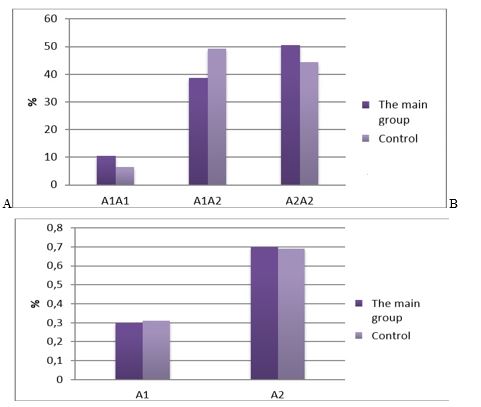
Telomeres length
The length of telomeres in the peripheral blood lymphocytes of the main and control groups are highly variable and do not correlate with age (see figure
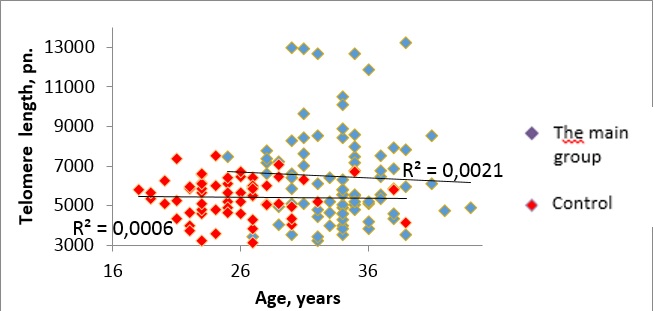
We also compared average telomere lengths in carriers of different genotypes in the main group, and found that the longest telomeres are present in carriers of the A1A2 and A2A2 genotypes, while carriers of the A1A1 genotype tend to have shorter telomeres (Figure
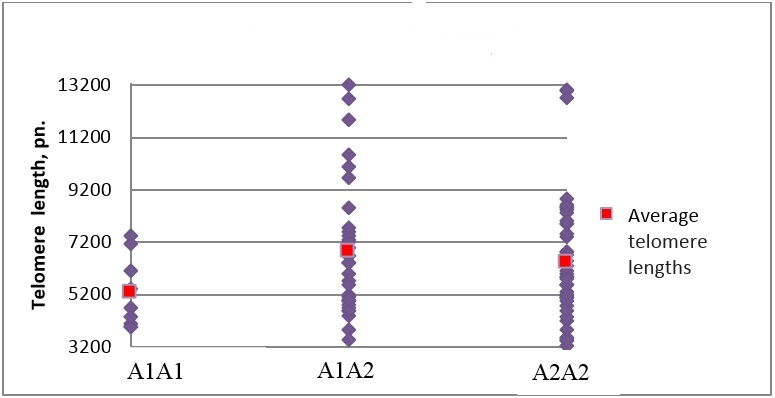
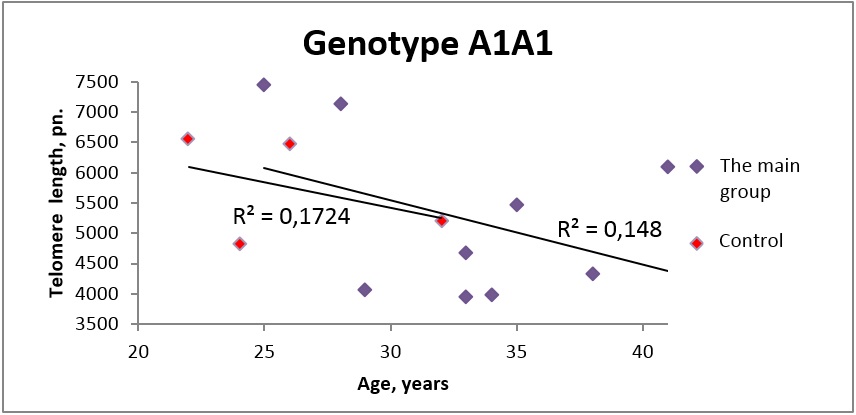
In a joint examination of telomere lengths, age, and polymorphismsA1A2 and A2A2, no reliable link was found. This means that by carriers of these genotypes, telomere length decreases with age significantly less than by A1A1 carriers (Figures
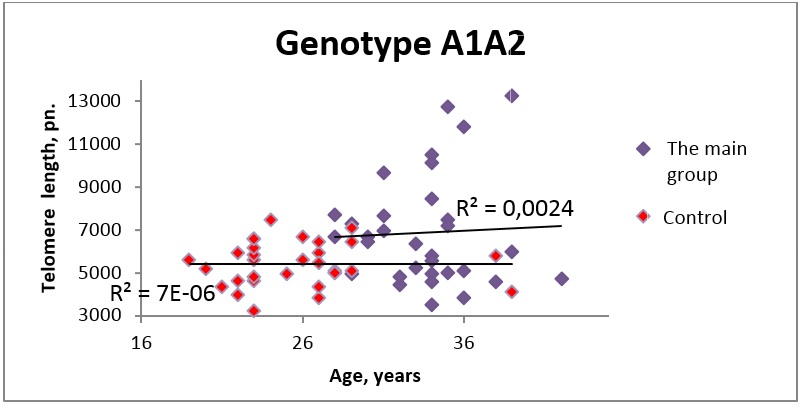
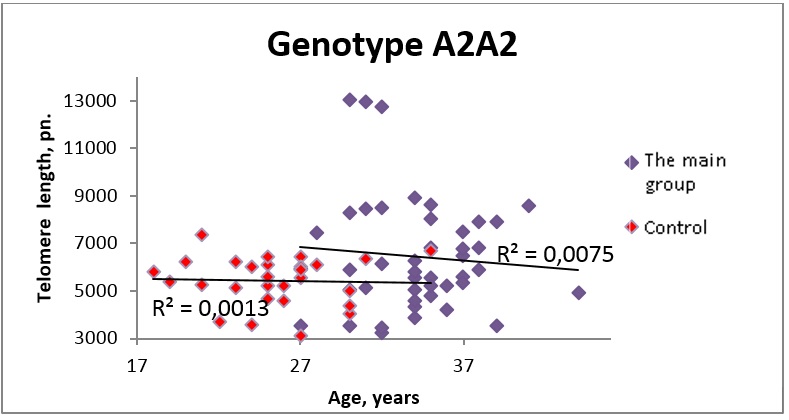
Respondents with genotype A1A1 have shorter telomeres. This means that they are most vulnerable to long-term stress. Correlation between A2 allele of 5-HTR2A gene and stable telomere length in both groups was also registered. In the course of ageing, long telomeres do not decrease reliably by carriers of this allele. In the main group, a large number of significantly longer telomeres are observed than in the control.
Conclusion
The data obtained by us confirm the fact that the serotonin system takes active part in dealing with long-term stress - in particular, the serotonin 2A receptor (5-HTR2A). In this case, carriers of the allele A2 have got protective mechanisms that help maintain the length of telomeres or even increase it, to avoid accelerated aging, as a result of prolonged stress. Probably, in this situation, the activity of telomerase increases, contributing to the maintenance of telomere length. A similar reaction was earlier observed in the study comparing influence of traditional and of non-traditional music. Music which was not traditional for the Ss, tended to be perceived as stressful, in some cases resulting in a shortening of telomeres. However, in some volunteers this shortening was prevented by an increase in telomerase activity (Spivak, Urazova, Zakharchuk, & Spivak, 2018). Unfortunately, due to the relatively small size of the groups, we could not establish reliable connection with the polymorphism of the genes of the serotonin system. Correlation with an increase in telomerase activity was also observed in carriers of the ApoE allele associated with the predisposition to Alzheimer's disease. This supposition is corroborated by structurally similar data, acquired in studies of relatives of patients suffering from Alzheimer's disease (Damjanovic et al., 2007), and of carriers of the allele of predisposition to this disease (APOE ε4, cf. Wikgren et al., 2012), as well as to depression (Wolkowitz et al., 2012). Also, Jacobs, Kroenke, Lin, Epel, Kenna, Blackburn, & Rasgon (2013) showed that replacement hormone therapy in female carriers of the genotype ApoE4 leads to reliable telomere elongation. This genotype can also affect the level of 5-HT2A serotonin receptor. Low level of telomerase activity is associated with chronic stress in Alzheimer patients, however response to acute stress is similar by them and by members of the control group (Epel, Lin, Dhabhar, Wolkowitz, Puterman, Karan, & Blackburn, 2010). Chhibber & Zhao (2017), using a mice model, showed that ApoE influenced the expression of brain-derived neurotrophic factor (BDNF) and the 5-HTR2A serotonin receptor in an isoform-dependent manner, with the ApoE4 brain exhibiting the lowest level of BDNF, and the highest level of 5-HTR2A. In addition, both presynaptic and postsynaptic proteins were downregulated, indicating a synaptic deficit in ApoE4 brains.
Many studies describe the association of the A2 allele with unfavorable psychological characteristics, such as increased anxiety, alcoholism, suicidal tendencies, possible risk of developing schizophrenia.
It is possible that longer telomeres, and absence of telomere length dependence on age in carriers of the A2 allele, are just a result of a compensatory increase in telomerase activity, due to a higher rate of telomere shortening. This may indicate that, under long-term stress, the A2 allele becomes protective.
Similar results were obtained at our Radiation Cytology Laboratory, Institute of Cytology, Russian Academy of Sciences last year: presence of a link between the genotype A2A2 and longer telomeres was demonstrated in male subjects.
On the other hand, we found that respondents in the main group were homozygous for the A1 allele, and, on average, had shorter telomeres, compared to carriers of the other two genotypes. In the control group, such a relationship was not found. However, in both groups, the telomere length was negatively related to age. This can be explained by the fact that under conditions of prolonged stress, carriers of allele A1, which is characterized by a higher level of expression of the 5-HTR2A gene, had more receptors on the surface of the tonsil neurons, which is associated with longer excitation duration. Consequently, they showed a more pronounced reaction of anxiety and fear to stress.
The results obtained earlier in our laboratory show that the A1A1 genotype was practically absent in the oldest age group (> 80 years), and that it was associated with shorter telomeres in other age groups. The A2A2 genotype, on the contrary, predominated in the older age category and it was associated with longer telomeres (Smirnova et al., 2012).
In the future, we hope to measure the activity of telomerase in all Ss involved into our study, and to detect the methylation level of the 5-HTR2A gene, since it is associated with accelerated aging.
The results obtained by now would allow to take into account genetic resistance to long-term stress when screening candidate for definite types of education and employment, which implies the conditions of long unavoidable stress.
Acknowledgments
The present study was supported by the Russian Foundation for Basic Research, grant 16-06-00172а.
References
- Anisimov, V.N. (2003). Molekularnue I physiologicheskie mechanizmu stareniya [Molecular and physiological mechanisms of aging.] St. Petersburg: The science. (In Rus.).
- Beery, A.K., Lin, J., Biddle, J.S., Francis, D.D., Blackburn, E.H., & Epel, E.S. (2012). Chronic stress elevates telomerase activity in rats. Biol Lett. 8(6), 1063-1066. doi: 10.1098/rsbl.2012.0747.
- Bernadotte, A., Mikhelson, V.M., & Spivak, I.M. (2016). Markers of senescence. Telomere shortening as a marker of cellular senescence. Aging (Albany NY), 8(1), 3-11. Doi: 10.18632/aging.100871
- Bouso, J.C., Dos Santos, R.G., Alcázar-Córcoles, M.Á., & Hallak, J.E.C. (2018). Serotonergic psychedelics and personality: A systematic review of contemporary research. Neurosci Biobehav Rev. 87, 118-132. doi: 10.1016/j.neubiorev.2018.02.004.
- Chang, C.C., Fang, W.H., Chang, H.A., Chang, T.C., Shyu, J.F., & Huang, S.Y. (2017). Serotonine 2A receptor (5-HT2A) gene promoter variant interacts with chronic perceived stress to modulate resting parasympathetic activity in humans. Psychoneuroendocrinology. 76,119-126. doi: 10.1016/j.psyneuen.2016.11.015.
- Chhibber, A., & Zhao, L. (2017). ERβ and ApoE isoforms interact to regulate BDNF-5-HT2A signaling and synaptic function in the female brain. Alzheimers Res Ther. ,9 (1), 79. doi: 10.1186/s13195-017-0305-3.
- Damjanovic, A.K., Yang, Y., Glaser, R., Kiecolt-Glaser, J.K., Nguyen, H., Laskowski, B, Zou, Y., Beversdorf, D.Q., & Weng, N.P. (2007). Accelerated telomere erosion is associated with a declining immune function of caregivers of Alzheimer's disease patients. J. Immunol. 179 (6), 4249–4254.
- Daubenmier, J., Lin, J., Blackburn, E., Hecht, F.M., Kristeller, J., Maninger, N., Kuwata, M., Bacchetti, P., Havel, P.J., & Epel, E. (2012). Changes in stress, eating, and metabolic factors are related to changes in telomerase activity in a randomized mindfulness intervention pilot study. Psychoneuroendocrinology. 37(7), 917–928. doi: 10.1016/j.psyneuen.2011.10.008.
- Deng, W., Cheung, S.T., Tsao, S.W., Wang, X.M., & Tiwari, A.F. (2016). Telomerase activity and its association with psychological stress, mental disorders, lifestyle factors and interventions: A systematic review. Psychoneuroendocrinology. 64, 150-163. doi: 10.1016/j.psyneuen.2015.11.017.
- D'Mello, M.J., Ross, S.A., Briel, M., Anand, S.S., Gerstein, H., & Pare, G. (2015). Association between shortened leukocyte telomere length and cardiometabolic outcomes: systematic review and meta-analysis. Circulation Cardiovascular genetics, 8, 82-90. doi: 10.1161/CIRCGENETICS.113.000485.
- Dressler, W.W., Balieiro, M.C., Ferreira, de Araújo L., Silva, W.A. Jr, & Ernesto Dos Santos, J. (2016a). Culture as a mediator of gene-environment interaction: Cultural consonance, childhood adversity, a 2A serotonin receptor polymorphism, and depression in urban Brazil. Soc Sci Med. 161, 109-117. doi: 10.1016/j.socscimed.2016.05.033.
- Dressler, W.W., Balieiro, M.C., de Araújo, L.F., Silva, W.A. Jr,& Ernesto Dos Santos, J.E. (2016b). The interaction of cultural consonance and a polymorphism in the 2A serotonin receptor in relation to depression in Brazil: failure to replicate previous findings. Am J Hum Biol. 28(6), 936-940. doi: 10.1002/ajhb.22875.
- Eastwood, J.R., Mulder, E., Verhulst, S., & Peters, A. (2017). Increasing the accuracy and precision of relative telomere length estimates by RT qPCR. Mol Ecol Resour. doi: 10.1111/1755-0998.12711.
- Epel, E.S., Lin, J., Dhabhar, F.S., Wolkowitz, O.M., Puterman, E., Karan, L., & Blackburn, E.H. (2010). Dynamics of telomerase activity in response to acute psychological stress. Brain Behav Immun. 24(4), 531–539. doi: 10.1016/j.bbi.2009.11.018.
- Epel, E.S., Blackburn, E.H., Lin, J., Dhabhar, F.S., Adler, N.E., Morrow, J.D., & Cawthon, R.M. (2004). Accelerated telomere shortening in response to life stress. Proceedings of the National Academy of Sciences of the United States of America, 101, 17312-17315. DOI:10.1073/pnas.0407162101
- Höfer, P., Schosser, A., Calati, R., Serretti, A., Massat, I., Kocabas, N.A., … Kasper, S. (2016). The impact of serotonin receptor 1A and 2A gene polymorphisms and interactions on suicide attempt and suicide risk in depressed patients with insufficient response to treatment--a European multicentre study. Int Clin Psychopharmacol. 31(1), 1-7. doi: 10.1097/YIC.0000000000000101.
- Jacobs, E.G., Kroenke, C., Lin, J., Epel, E.S., Kenna, H.A., Blackburn, E.H., & Rasgon, N.L. (2013). Accelerated cell aging in female APOE-epsilon4 carriers: implications for hormone therapy use. PloS one, 8, e54713.
- Jiang, Y., Palizhati, A., Gao, X.Y., Guan, S.Z., & Liu, J.W. (2016). Association between 5-hydroxytryptamine 2A receptor gene polymorphisms and susceptibility to occupational stress in oilfield workers. Zhonghua Lao Dong Wei Sheng Zhi Ye Bing Za Zhi., 34(10), 742-745. doi: 10.3760/cma.j.issn.1001-9391.2016.10.005. [in Chinese]
- Ghasemi, A., Seifi, M., Baybordi, F., Danaei, N.,& Samadi Rad, B. (2018). Association between serotonin 2A receptor genetic variations, stressful life events and suicide. Gene. 658, 191-197. doi: 10.1016/j.gene.2018.03.023.
- Golimbet, V. E., Alfimova, MV, Mityushina, N. G., & Asanov, A. Yu. (2003). Genu serotoninergicheskoi sistemu, osobrnnosti povedeniya i psyhicheskie narusheniya. [Genes of the serotonergic system, features of behavior and mental disorders.] Medical genetics. 7, 297–304. (In Rus.).
- Gong, P., Liu, J., Blue, P.R., Li, S., & Zhou, X. (2015). Serotonin receptor gene (HTR2A) T(102)C polymorphism modulates individuals' perspective taking ability and autistic-like traits. Front Hum Neurosci. 9, 575. doi: 10.3389/fnhum.2015.00575.
- Kim, T.Y., Kim, S.J., Choi, J.R., Lee, S.T., Kim, J., Hwang, I.S., Chung, H.G., . . . Kang, J.I. (2017). The effect of trauma and PTSD on telomere length: An exploratory study in people exposed to combat trauma. Scientific Reports. 7(1), 4375. doi: 10.1038/s41598-017-04682-w.
- Kovalenko, N.A., Zhdanov, D.D., & Kovalenko, T.F. (2013). Vozmojnosti i effectu activacii telomerasu.(obzor).[Possibilities and effects of telomerase activation (review).] Molecular Biology, 47 (4), 544–557. DOI: 10.7868/S0026898413040071 (In Rus.).
- Lapham, K., Kvale, M.N., Lin J., Connell, S., Croen, L.A., Dispensa, B.P., Fang, L., … Blackburn, E.H. (2015). Automated Assay of Telomere Length Measurement and Informatics for 100,000 Subjects in the Genetic Epidemiology Research on Adult Health and Aging (GERA) Cohort. Genetics. 200(4), 1061-1072. doi: 10.1534/genetics.115.178624.
- Lavretsky, H., Epel, E.S., Siddarth, P., Nazarian, N., Cyr, N.S., Khalsa, D.S., Lin, J., … Irwin, M.R. (2013). A pilot study of yogic meditation for family dementia caregivers with depressive symptoms: effects on mental health, cognition, and telomerase activity. Int J Geriatr Psychiatry, 28(1), 57–65. doi: 10.1002/gps.3790.
- Lengacher, C.A., Reich, R.R., Kip, K.E., Barta, M., Ramesar, S., … Park, J.Y. (2014). Influence of mindfulness-based stress reduction (MBSR) on telomerase activity in women with breast cancer (BC). Biol Res Nurs. 16(4), 438-47. doi: 10.1177/1099800413519495.
- Li, P., Liu, T., Liu, J., Zhang, Q., Lou, F., Kong, F., Cheng, G., . . . Xu, D. (2014). Promoter polymorphism in the serotonin transporter (5-HTT) gene is significantly associated with leukocyte telomere length in Han Chinese. PLoS One. 9(4), e94442. doi: 10.1371/journal.pone.0094442.
- Matsunaga, M., Kawamichi, H., Umemura T., Hori, R., Shibata, E., Kobayashi, F, … Ohira, H. (2017). Neural and Genetic Correlate2017s of the Social Sharing of Happiness. Front Neurosci. 11, 718. doi: 10.3389/fnins.2017.00718.
- Mikhelson, VM, & Gamaley, I.A. (2010). Ukorochenie telomer – edinstvennui mekhanizm stareniya. [The shortening of telomeres is the only mechanism of aging.] Glad. biology. Radioecology.50, 269 – 275. (In Rus.).
- Mitchell, C., McLanahan, S., Schneper, L., Garfinkel, I., Brooks-Gunn, J., & Notterman, D. (2017). Father Loss and Child Telomere Length. Pediatrics. 140(2). pii: e20163245. doi: 10.1542/peds.2016-3245.
- Mitchell, C., Hobcraft, J., McLanahan, S.S., Siegel, S.R., Berg, A., Brooks-Gunn, J., Garfinkel, I., & Notterman, D. (2014). Social disadvantage, genetic sensitivity, and children's telomere length. Proc Natl Acad Sci U S A. 111(16), 5944-9. doi: 10.1073/pnas.1404293111.
- O’Callaghan, N.J., Dhillon, V.S., Thomas, P., & Fenech, M. (2008). A quantitative real-time PCR method for absolute telomere length. Biotechniques. 44, 807 – 809. doi: 10.2144/000112761.
- Ornish, D., Lin, J., Daubenmier, J., Weidner, G., Epel, E., Kemp, C., Magbanua, M.J., Marlin, R., Yglecias, L., Carroll, P.R., & Blackburn, E.H. (2008). Increased telomerase activity and comprehensive lifestyle changes: a pilot study. Lancet Oncol. 9(11):1048-1057. doi: 10.1016/S1470-2045(08)70234-1.
- Parade, S.H., Novick, A.M., Parent, J., Seifer, R., Klaver, S.J., Marsit, C.J., Gobin, A.P., Yang, B.Z., & Tyrka A.R. (2017). Stress exposure and psychopathology alter methylation of the serotonin receptor 2A (HTR2A) gene in preschoolers. Dev Psychopathol. 29(5), 1619-1626. doi: 10.1017/S0954579417001274.
- Runov, A.L., Vonsky, M.S., & Michelson, V.M. (2015). Stepen metilirovaniya DNK I dlina telomere kak osnova dlya postroeniya biologicheskih chasov stareniya. [The level of DNA methylation and telomere length as the basis for constructing a model of biological aging hours.] Cytology, 57(3), 192-196. (In Rus.).
- Schutte, N.S., & Malouff, J.M. (2014). A meta-analytic review of the effects of mindfulness meditation on telomerase activity. Psychoneuroendocrinology. 42, 45-48. doi: 10.1016/j.psyneuen. 12.017.
- Schosser, A.,& Kasper, S. (2009). The role of pharmacogenetics in the treatment of depression and anxiety disorders. Int Clin Psychopharmacol. 24(6), 277-288. doi: 10.1097/YIC.0b013e3283306a2f.
- Smirnova, T. Yu., Runov, A. L., Vonsky, M. S., Spivak, D. L., Zakharchuk, A.G., Mikhelson, V. M., & Spivak, I. M. (2012). Dlina telomere v populyacii dolgojitelei Severo-Zapadnogo regiona Rossii. [Telomere Length in a Population of Long-Lived People of the Northwestern Region of Russia.] Cytology. 54(5), 439 – 445. (In Rus.).
- Spivak, D.L., Urazova, I.S., Zakharchuk, A.G., & Spivak, I.M. (2018). Fiziologicheskie aspektu culturnogo nasledovaniya I ih molekularno-biologicheskie korrelyatu. [Psychological aspects of cultural inheritance and their molecular-biological correlates.] Culturological J.,2(32), 1-18. Retrieved from http://cr-journal.ru/rus/journals/438.html&j_id=35 (In Rus.).
- Spivak, I.M., Mikhelson, V.M., & Spivak, D.L. (2016). Dlina telomere, aktivnost telomerazu, stress I starenie. [Telomere length, telomerase activity, stress and aging.] Advances in Gerontology . 6(1), 29–35. (In Rus.).
- Spivak, I.M., Khesina, A.A., & Spivak, D.L. (2015). Starenie I dolgojitelstvo na kletochnom I organizmennom urovne. [Aging and longevity at the cellular and organismal levels.] Sarbrücken: Lambert Academic Publishing. (In Rus.).
- Tolahunase, M,, Sagar, R., & Dada, R. (2017). Impact of Yoga and Meditation on Cellular Aging in Apparently Healthy Individuals: A Prospective, Open-Label Single-Arm Exploratory Study. Oxid Med Cell Longev. Vol. 2017, Article ID 7928981. doi: 10.1155/2017/7928981.
- Wentzensen, I.M., Mirabello, L., Pfeiffer, R.M., & Savage, S.A. (2011). The association of telomere length and cancer: a meta-analysis. Cancer epidemiology, biomarkers & prevention : a publication of the American Association for Cancer Research, cosponsored by the American Society of Preventive Oncology 20, 1238-1250. doi: 10.1158/1055-9965.EPI-11-0005.
- Wikgren, M., Karlsson, T., Nilbrink, T., Nordfjäll, K., Hultdin, J., Sleegers, K., … Norrback, K.F. (2012). APOE ε4 is associated with longer telomeres, and longer telomeres among ε4 carriers predicts worse episodic memory. Neurobiol Aging. 33(2), 335-344. doi: 10.1016/j.neurobiolaging.2010.03.004.
- Wolkowitz, O.M., Mellon, S.H., Epel, E.S., Lin, J., Reus, V.I., Rosser, R., … Blackburn, E.H. (2012). Resting leukocyte telomerase activity is elevated in major depression and predicts treatment response. Mol Psychiatry. 17(2), 164-172. DOI:10.1038/mp.2010.133
- Wolkowitz, O.M., Mellon, S.H., Epel, E,S., Lin, J., Dhabhar, F.S., Su, Y., … Blackburn, E.H. (2011). Leukocyte telomere length in major depression: correlations with chronicity, inflammation and oxidative stress-preliminary findings. PLoS One. 23;6(3), e17837. doi: 10.1371/journal.pone.0017837.
- Wu, H., Wang, F.F., Zhou, W.Y., Gu, G.Z., & Yu, S.F. (2016). Influence of occupational stress and 5-hydroxytryptamine 2A receptor gene polymorphisms on depression in workers in a thermal power plant. Zhonghua Lao Dong Wei Sheng Zhi Ye Bing Za Zhi. 34(10), 721-725. doi: 10.3760/cma.j.issn.1001-9391.2016.10.001. [in Chinese]
- Zalli, A., Carvalho, L.A., Lin, J., Hamer, M., Erusalimsky, J.D., Blackburn, E.H., & Steptoe, A. (2014). Shorter telomeres with high telomerase activity are associated with raised allostatic load and impoverished psychosocial resources. Proc Natl Acad Sci USA. 111(12), 4519–4524. doi: 10.1073/pnas.1322145111.
- Zhao, J., Miao, K., Wang, H., Ding, H., & Wang, D.W. (2013). Association between telomere length and type 2 diabetes mellitus: a meta-analysis. PloS one 8, e79993.
Copyright information

This work is licensed under a Creative Commons Attribution-NonCommercial-NoDerivatives 4.0 International License.
About this article
Publication Date
30 December 2018
Article Doi
eBook ISBN
978-1-80296-050-1
Publisher
Future Academy
Volume
51
Print ISBN (optional)
-
Edition Number
1st Edition
Pages
1-2014
Subjects
Communication studies, educational equipment,educational technology, computer-aided learning (CAL), science, technology
Cite this article as:
Spivak, I., Tkachuk, N., Zhekalov, A., & Dolinina, T. (2018). Role Of Genotype In Maintaining Trlomere Length At Prolonged Psychological Stress. In V. Chernyavskaya, & H. Kuße (Eds.), Professional Сulture of the Specialist of the Future, vol 51. European Proceedings of Social and Behavioural Sciences (pp. 515-527). Future Academy. https://doi.org/10.15405/epsbs.2018.12.02.56

